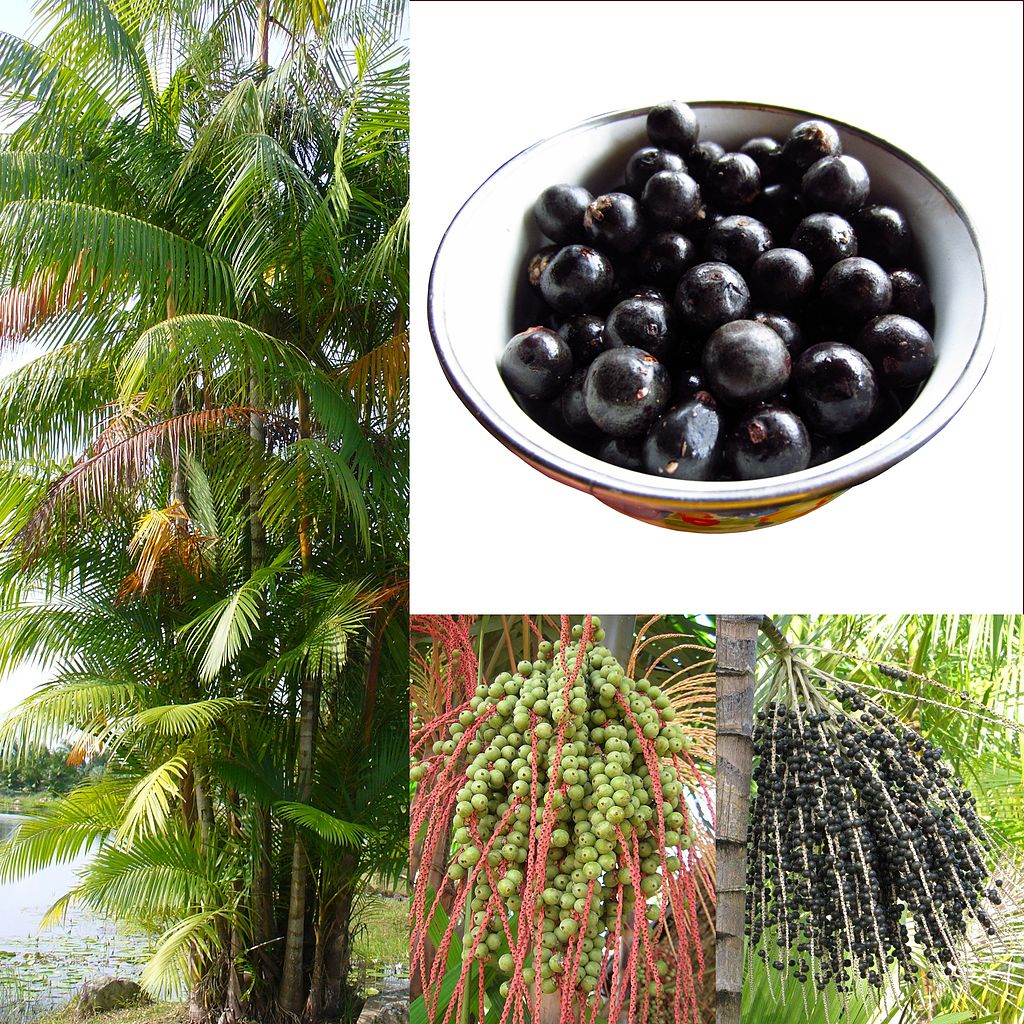Euterpe oleracea Mart. - syn.Euterpe badiocarpa Barb. Rodr. - Arecaceae - açai, assai palm, cabbage palm, Acai, Kohlpalme
Palm tree, native to the rainforests of South America; cultivated for its fruit (acai berry) and hearts of palm. wikipedia
„The freshly pressed açaí wine has a very distinct flavor: it is a thick and creamy juice, with a lingering taste that is actually much stronger and unique than anything you would taste from an industrialized version of the juice. The flavor is similar to a mixture of blueberry and unsweetened chocolate [or more like Olea europaea?! A.Kraska]. Since the juice is not sweet at all, the versions sold elsewhere have a lot of added sugar. That’s why it comes as a little bit of a surprise to most outsiders that the locals consume the açaí with fried fish and rice, topped with manioc flour.“ http://seekingsustenance.wordpress.com/2010/03/08/the-truth-about-acai/
„Açai, which is also named assai, Euterpe oleracea Mart., manaca, and South American plum (Alexandre and others 2004; Sangronis and others 2006), is a native Amazon berry which grows on the açaizeiro tree. Açaizeiro
is a multi-stemmed monoecious palm, and the açaizeiro tree can reach up to thirty meters in height. The mature açai fruit is purple in color and round-shaped with 1 to 1.5 centimeter in diameter. Açai skin is thin and fibrous, and under the skin is a thin layer of edible fruit pulp, whereas the seed contributes most of the fruit’s size (Pozo-Insfran and others 2004). It is not eaten in fresh form but usually macerated with water, and seeds are separated from the fruit pulp. The thick, purple colored aҫai pulp can be consumed directly or further frozen or freeze-dried for other uses (Pacheco-Palencia and others 2007). The aҫai pulp has a creamy texture, greasy mouthfeel, and a hint of nutty flavor. Aҫai is widely used in making beverages, ice creams, jellies, and pies in northern South America. In the U.S., aҫai has been formulated into a variety of products, such as tablets, powders, energy drinks, juices, smoothies, and sorbets…
The objective of this study was to determine the flavor profiles and antioxidant capacity of aҫai puree and aҫai-flavored multifunctional ice creams, containing varying dietary fiber (0, 5, 10, and 15%), probiotics (10
8cfu/ mL), and prebiotics (4%), in addition to aҫai (12%), using headspace-solid-phase microextraction (SPME) coupled with GC/MS. The results showed that (Z)-2-pentenol, hexanal, hexenal isomers, (Z)-3-hexenol, 2-hexenol, styrene, heptanal, benzaldehyde, benzyl alcohol, octenol, octanal, 2-octenal, octanol, nonanal and isocaryophyllene were present in both aҫai puree and aҫai-flavored multifunctional ice creams. Heptanone, 4-decyne and undecanone were only found in ice cream samples but not in the puree, while α-copaene, 2,4-hexadienal and (Z)-linalool oxide were only present in the puree.“
[Sensory analysis, instrumental analysis and consumers’ acceptance toward multifunctional ice creams, Ting-Ning Lin, Diss. University of Missouri, 2012 ] PDF
The edible fruits are used as antioxidant, functional food. „The dark colouring of the fruit is due to the presence of high levels of anthocyanins with antioxidant activity, especially cyanidin 3-O-glucoside and cyanidin 3-O-rutoside… In small human studies a certain level of protection against ROS [reactive oxygen species] and a significant reduction of lipid peroxidation could be proven.“
[Medicinal Plants of the World. Ben-Erik Van Wyk and Michael Wink, Pretoria 2017, 151]

Acai, derivative work: Agnieszka Kwiecień (Nova) from Flickr by Constantino Lagoa and Eli Duke (eliduke)
CC BY-SA 3.0
Wikimedia Commons
